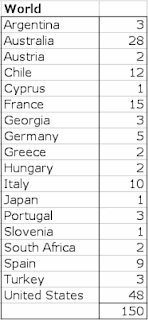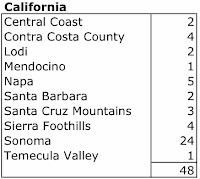Recently, I did an audio interview for The Wonderful World of Wine (WWW). This show is hosted by Mark Lenzi And Kim Simone, and “explores all things wine with you: trends, news, education, and so much more.” You should check it out.
Episode 249 of their series is the interview with:
David Morrison, who is a data expert in the world of wine and has been passionately writing about it for years, garnering a large following of wine enthusiasts around the globe. With his extensive knowledge and unique perspective, David has become a trusted authority in the wine data industry.
Sounds good to me! The interview recording can be found on their SoundCloud channel, and on their Youtube channel.
This follows the interview I did a year ago with Wine For Normal People, episode 424 on Youtube.
Oldest recorded vines and vineyards
At roughly the same time as this interview, I also did an online presentation for the Old Vine Conference. According to the conference agenda, David covered: “how he used the old vine registry to analyse the distribution of old vineyards around the world, and created some charts.”
On The Wine Gourd blog, I covered a lot of this material in two earlier posts:
However, there were some things that did not appear in those posts, and I cover some of this information here.
Many of you will have encountered The Old Vine Registry recently, which is an ambitious plan to catalogue the world’s oldest vines as a fully searchable and updatable online database. It officially launched on June 28 2023 (Old Vine Registry launched), as: “the world’s first crowd-sourced global database of living historic vineyard sites.” Its goal is: “to create the world’s most authoritative record of these vineyards in the hopes that, through greater awareness and attention, these vineyards and the wines they produce will survive and thrive.”
There have been a number of web sites introducing the concept, but the best of them is by one of the participants, Alder Yarrow (Vinography Wine Blog): Introducing the Old Vine Registry. You should read this if you have not already done so.
There is no legal or generally agreed definition for “old” (Old vine), but the Old Vine Conference uses a minimum vine age of 35 years. So, the Registry notes that: “Vineyards that have been left to grow and thrive beyond that 35-year mark can officially be considered old.” Yarrow observes that: “We have about 2,200 records of old vine vineyards … There should be another 10,000 from around the world added by the time we’re done.”
On this age basis, most of the current data come from Portugal (822 recorded vineyards), followed by Spain (383), the United States (334), Australia (208), and France (142).
However, here I am going to be more strict than this. Below, I have summarized those records for vines that are at least 125 years old. There are currently 150 such records, which may be more than you expected, even globally. The oldest recorded vineyard is c. 600 years old (in Germany), with another three at c. 450 (Georgia, Germany, Slovenia), and one at 350 years (Italy).
The full collection of vine ages (>125) is shown in this graph. This is pretty impressive, of course; but we should note that there are actually 34 known trees with verified ages that are more than twice that of the oldest grapevine (ie. 1,200+ years) (List of oldest trees).
We can also look at which countries these oldest vines come from. Here is a table listing the vineyard count for each of the relevant countries.
Note that 32% of these vines are in the United States of America, and 19% are in Australia. The New World outshines the Old World, when it comes to vineyard preservation! Not unexpectedly, all of the USA vineyards are in California. Here is a list of the vineyard count for each of the relevant counties. Note that 50% are in Sonoma county.
Old vines (and their vineyards) have interest both for their contribution to agricultural history and biodiversity; but they do also have other more immediate practical uses for the wine industry. For example, Enrico Marcolungo (store manager, Shrine to the Vine) sees old vines as being “one of the most effective marketing tools” there is at the moment. “It definitely adds interest to the conversation when you are recommending wine” (Wynns debate: Buyers on Coonawarra’s premium potential). Try it for yourself.
Many of you will have encountered The Old Vine Registry recently, which is an ambitious plan to catalogue the world’s oldest vines as a fully searchable and updatable online database. It officially launched on June 28 2023 (Old Vine Registry launched), as: “the world’s first crowd-sourced global database of living historic vineyard sites.” Its goal is: “to create the world’s most authoritative record of these vineyards in the hopes that, through greater awareness and attention, these vineyards and the wines they produce will survive and thrive.”
There have been a number of web sites introducing the concept, but the best of them is by one of the participants, Alder Yarrow (Vinography Wine Blog): Introducing the Old Vine Registry. You should read this if you have not already done so.
There is no legal or generally agreed definition for “old” (Old vine), but the Old Vine Conference uses a minimum vine age of 35 years. So, the Registry notes that: “Vineyards that have been left to grow and thrive beyond that 35-year mark can officially be considered old.” Yarrow observes that: “We have about 2,200 records of old vine vineyards … There should be another 10,000 from around the world added by the time we’re done.”
On this age basis, most of the current data come from Portugal (822 recorded vineyards), followed by Spain (383), the United States (334), Australia (208), and France (142).
However, here I am going to be more strict than this. Below, I have summarized those records for vines that are at least 125 years old. There are currently 150 such records, which may be more than you expected, even globally. The oldest recorded vineyard is c. 600 years old (in Germany), with another three at c. 450 (Georgia, Germany, Slovenia), and one at 350 years (Italy).
The full collection of vine ages (>125) is shown in this graph. This is pretty impressive, of course; but we should note that there are actually 34 known trees with verified ages that are more than twice that of the oldest grapevine (ie. 1,200+ years) (List of oldest trees).
We can also look at which countries these oldest vines come from. Here is a table listing the vineyard count for each of the relevant countries.
Note that 32% of these vines are in the United States of America, and 19% are in Australia. The New World outshines the Old World, when it comes to vineyard preservation! Not unexpectedly, all of the USA vineyards are in California. Here is a list of the vineyard count for each of the relevant counties. Note that 50% are in Sonoma county.
Old vines (and their vineyards) have interest both for their contribution to agricultural history and biodiversity; but they do also have other more immediate practical uses for the wine industry. For example, Enrico Marcolungo (store manager, Shrine to the Vine) sees old vines as being “one of the most effective marketing tools” there is at the moment. “It definitely adds interest to the conversation when you are recommending wine” (Wynns debate: Buyers on Coonawarra’s premium potential). Try it for yourself.





Paul White of www.winedisclosures.com here. Those statistics are deceptive. It's more a case of New World producers having previously identified old vines. In researching my book, Talha Tales: Portugal's Ancient Answer to Amphora Wine I ran across dozens in Portugal that are over a century or near it. The locals just haven't realized the marketing potential in labelling their bottles as old vine yet. Many of these were registered around 1930-31 during Salazar government and at that point were very old already. Many pre-phylloxera, tiny parcels are currently dumped into cooperative blends without being separated out to show their strengths. But all this is changing.
ReplyDeleteI used to teach statistical analysis to biologists, and I can therefore honestly say that all data can be deceptive. However, we work with what we have. Moreover, as you point out, it is how we interpret the data that is most important — the more information that we have, then the better will be our interpretation. So, I am glad that you foresee helpful changes.
Delete